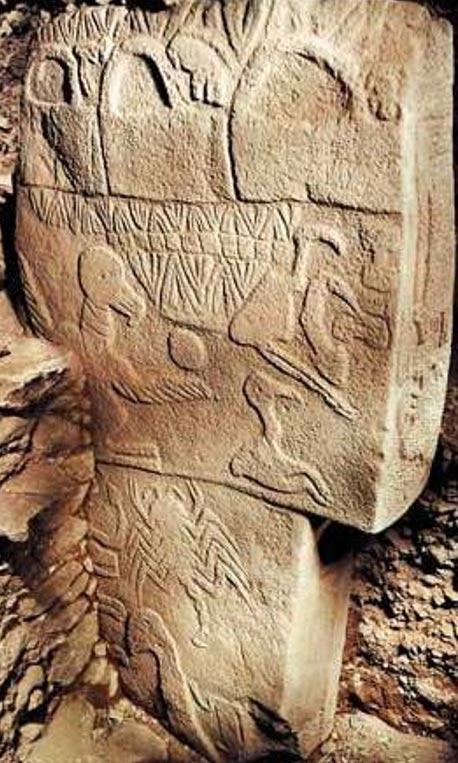
Archaeologists find 12,000-year-old pictograph at Gobeklitepe
Excavations being conducted at the ancient city of Göbeklitepe in Turkey have uncovered an ancient pictograph on an obelisk which researchers say could be the earliest known pictograph ever discovered.
Apictograph is an image that conveys meaning through its resemblance to a physical object. Such images are most commonly found in pictographic writing, such as hieroglyphics or other characters used by ancient Sumerian and Chinese civilizations. Some non-literate cultures in parts of Africa, South America and Oceania still use them.
“The scene on the obelisk unearthed in Göbeklitepe could be construed as the first pictograph because it depicts an event thematically” explained Director of the Şanlıurfa Museum, Müslüm Ercan, to theHurriyet Daily News. Ercan is leading the excavation at Göbeklitepe. “It depicts a human head in the wing of a vulture and a headless human body under the stela. There are various figures like cranes and scorpions around this figure. This is the portrayal of a moment; it could be the first example of pictograph. They are not random figures. We see this type of thing portrayal on the walls in 6,000-5,000 B.C. in Çatalhöyük [in modern-day western Turkey].”

The ‘Vulture-Stone’. Credit: Alistair Coombs
The artifacts discovered in the ancient city have provided information about ancient burial traditions in the area in which bodies were left in the open for raptors such as vultures to consume. According to Mr Ercan, this enabled the soul of the deceased to be carried into the sky. It was called “burial in the sky” and was depicted on the obelisks in Göbeklitepe. Such rituals were conducted in and around the city around 12,000 years ago.
Many of the items discovered on the site have not been seen before anywhere else in the world and thus are the first of their kind to be discovered.
Göbeklitepe is situated on the top of a hill about 15 kilometres away from Sanliurfa in South-eastern Turkey. The city can be dated back to 10,000 BC and consists of a series of circular and oval shaped structures that were first excavated by Professor Klaus Schmidt supported by the German Archaeological Institute. Schmidt travelled to the site having heard about it from accounts of otherprevious visits by anthropologists from the University of Chicago and Istanbul University in the 1960’s. Both institutions ignored the site, believing it to be nothing more than a medieval graveyard.
Artifacts found on the site indicate that the city was intended for ritual use only and not as a domain for human occupation. Each of the 20 structures consists of a ring of walls surrounding two T-shaped monumental pillars between 3 metres (9 feet) and 6 metres high (19 feet) and weighing between 40 and 60 tons.

Enormous T-shaped pillars at Göbeklitepe. Credit: Alistair Coombs
Archaeologists believe these pillars are stylised representations of human beings because of the human appendages carved into the stone. These images are accompanied by those of animals including foxes, snakes, wild boars, cranes and ducks.
The archaeologists believe Göbeklitepe was used as a religious centre. Geo-radar work has revealed evidence of 23 temple structures in the area. Two of the obelisks in the city were constructed in the form of a letter T and are positioned opposite each other within a circle of smaller, round obelisks.
Ercan said that the museum at Şanlıurfa contains a small sculpture of a pig that was discovered in front of the central stelas in the ‘C’ temple at Göbeklitepe. Such statues may have depicted sacred beings.
Work on the basic infrastructure of a roof to cover the site and help preserve its structures and artefacts has just been completed, ready for the construction of the roof itself. This is an EU project and the archaeologists aim to complete it in eight months’ time.
Featured image: Göbekli Tepe in Turkey is the oldest known temple in the world. Photo source: Wikimedia
















Comments
That we had a great global flood is evident from the fact it is mentioned across +50 ancient cultures spanning all continents. Also from clear geological evidence such as water erosion on the Sphinx and many other such erosion marks across the world dating from around that time. Also the ice cores in large parts of Antarctica are roughly 10k years old. Of course, all the stories across ancient cultures, from China, India, Sumeria, Mayas, Aztecs etc. Are so similar because they are based on actual historic cataclysms, not fiction. We are stupid to think they were stupid when they could build such amazing structures and had as much mathematical, architectural and astrological knowledge if not more than we have even today!!
Kristian: I'm curious for some references to support your statements about a 10.9 kya flood? To what archaeological records do you refer?
The great flood happened around 10.900 BC. These ruins like many others forming the largest, most impressive structures around the world where buried with mud when the "great deludge" was triggered by the Annunaki to wipe out their human creations. Scientists are completely stupid to disregard this fact, documented across all cultures on tablets and told in storied to this day. Most of these stories have been found to match the archaelogical record, so why disregard that there was a flood, that civilization and life etc. was brought here by aliens and dates 100.000 of years back. We would do the same thing if we had the technology!
Its more than 2600 years old statues for sale
The site may have been a Antediluvian dated from 4,096 to 2,370 BCE. It is NOT 12,000 years old. How did they date that with radiometrics? The site bears a striking resemblance to Rapi Nui (aka Easter Island). The letter T is seen in the top hats of the Moai. The horn-bill birds are similar to the "bird men" of Easter Island. Look at the hands of the Moai, looks like the same hands on belly here. That is NOT a human head. It is a bird's egg.
It could have been some Antediluvians who witnessed Utnapishtim (aka Noah) gather his beasts together for decades before the flood of 2370 BCE. The fertility symbols and giants have some bearing to Moses' words at Genesis 6th chapter. Out of fear of drowning they made effigies of their gods/deities in desire to survive Utnapishtim's prophecies of their impending demise. This area was only 250 miles from where Noah was operating as the "remote one" in the Steppes Region some 4,000+ years ago.
The T shape was ostensibly a reference to the deity TAMMUZ who was represented by the TAU symbol or the letter T. Later Sumerians would adopt this after the flood. This is an ancient temple but not to the Hebrew God YHWH who brought the flood. It was obviously an ancient pagan temple of the disobedient humans who sided with the fallen-ones and their chimeric offspring "the giants" (aka nephilim).
The only ancient "MESSAGE" here is disloyalty/disrespect to YHWH sucks! Don't do it! You won't like the outcome...
Pages